Themed collection New horizons in materials for energy conversion, optics and electronics

Introduction to new horizons in materials for energy conversion, optics and electronics
Jinlan Wang, Yuanjian Zhang, Seeram Ramakrishna and Guihua Yu introduce the cross-journal themed collection on new horizons in materials for energy conversion, optics and electronics, in celebration of the 120th anniversary of Southeast University, China.

Nanoscale Horiz., 2023,8, 714-715
https://doi.org/10.1039/D3NH90015K
Flexible two-dimensional MXene-based antennas
This minireview summarizes the recent cutting-edge works of 2D MXene-based flexible antennas, discusses the existing bottlenecks, and provides some guidelines for the future development of this promising field.
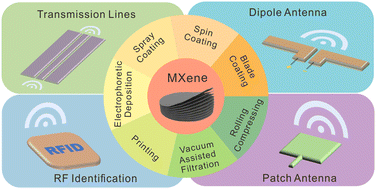
Nanoscale Horiz., 2023,8, 309-319
https://doi.org/10.1039/D2NH00556E
Metallene-related materials for electrocatalysis and energy conversion
As a member of graphene analogs, metallenes are a class of two-dimensional materials with atomic thickness and well-controlled surface atomic arrangement made of metals or alloys.

Mater. Horiz., 2023,10, 407-431
https://doi.org/10.1039/D2MH01213H
In situ characterisation for nanoscale structure–performance studies in electrocatalysis
We focus on the new horizons in operando/in situ characterisation techniques in electrocatalysis, providing a critical analysis of how advanced in situ techniques help us to deepen our understanding of reaction mechanisms and material evolution.

Nanoscale Horiz., 2023,8, 146-157
https://doi.org/10.1039/D2NH00447J
Surface acoustic wave induced phenomena in two-dimensional materials
Surface acoustic wave (SAW)–matter interaction provides a fascinating key for inducing and manipulating novel phenomena and functionalities in two-dimensional (2D) materials.

Nanoscale Horiz., 2023,8, 158-175
https://doi.org/10.1039/D2NH00458E
A nanoelectrode-based study of water splitting electrocatalysts
This review covers the recent nanoelectrode-based electrochemical studies on 0-dimensional and 2-dimensional catalytic nanomaterials for water splitting electrocatalysis.

Mater. Horiz., 2023,10, 52-64
https://doi.org/10.1039/D2MH01143C
Liquid-precursor-intermediated synthesis of atomically thin transition metal dichalcogenides
LPI-CVD growth not only avoids the use of solid powders, but also enables the uniform distribution of precursors on the substrate, which are favorable for the monolayer synthesis, substitution doping and corresponding heterostructures of 2D TMDs.
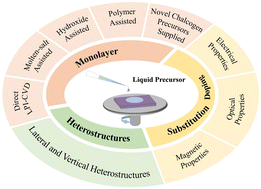
Mater. Horiz., 2023,10, 1105-1120
https://doi.org/10.1039/D2MH01207C
Copper-based catalysts for the electrochemical reduction of carbon dioxide: progress and future prospects
This review introduces fundamental aspects of the electrocatalytic CO2RR process together with a systematic examination of recent developments in Cu-based electrocatalysts for the electroreduction of CO2 to various high-value multicarbon products.

Mater. Horiz., 2023,10, 698-721
https://doi.org/10.1039/D2MH01218A
Microbial electrosynthesis: carbonaceous electrode materials for CO2 conversion
Microbial electrosynthesis (MES) is a sustainable approach to producing fuels and value-added chemicals from anthropogenic carbon dioxide (CO2).
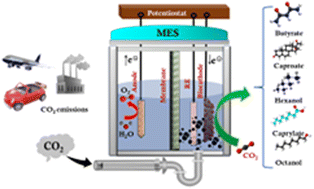
Mater. Horiz., 2023,10, 292-312
https://doi.org/10.1039/D2MH01178F
Life cycle of single atom catalysts: a Mössbauer study on degradation and reactivation of tetrapyrrolic Fe–N–C powders
Degradation of single-site model Fe–N–C powder tracked using cryo-Mössbauer spectroscopy suggests a simple mechanism comprising the oxidation of Fe(II) to Fe(III) followed by precipitation of iron oxide. Curiously, the characteristic doublet D2 is converted into D1 upon exposure to air.

Mater. Horiz., 2023,10, 5577-5583
https://doi.org/10.1039/D3MH00308F
Alkyl-C60 liquid electrets as deformable mechanoelectric generators
C60 moiety is shielded and liquefied by bulky yet flexible branched alkyl chains as excellent charge-holding liquid electrets enabling us to create mechanoelectric generators with ultimate deformability such as folding, twisting, and rolling.

Mater. Horiz., 2023,10, 3458-3466
https://doi.org/10.1039/D3MH00485F
The effects of intercalated environmental gas molecules on carrier dynamics in WSe2/WS2 heterostructures
Effective tuning of carrier dynamics in two-dimensional (2D) materials is significant for multi-scene device applications.
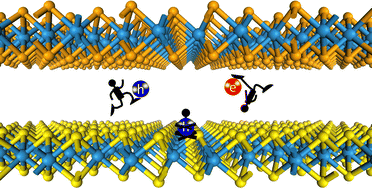
Mater. Horiz., 2023,10, 2417-2426
https://doi.org/10.1039/D3MH00420A
Selective spectral absorption of nanofibers for color-preserving daytime radiative cooling
The color-preserving daytime radiative cooling can be achieved by selective spectral absorption of nanofibers.
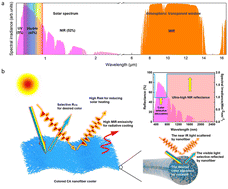
Mater. Horiz., 2023,10, 2487-2495
https://doi.org/10.1039/D3MH00391D
Single-atom alloy Ir/Ni catalyst boosts CO2 methanation via mechanochemistry
A new catalytic approach is pioneered to achieve CO2 methanation via a single atom alloy Ir/Ni catalyst using a ball-milling method.
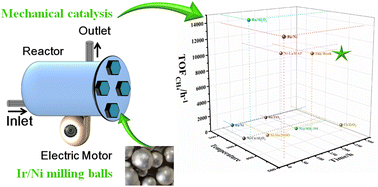
Nanoscale Horiz., 2023,8, 852-858
https://doi.org/10.1039/D3NH00040K
Large-area 2D bismuth antimonide with enhanced thermoelectric properties via multiscale electron–phonon decoupling
Multiscale defect engineering has been designed to decouple the electron–phonon transport in 2D bismuth antimony, simultaneously achieving high electrical and low thermal conductivity with 420% enhancement of the ZT value.

Mater. Horiz., 2023,10, 2053-2061
https://doi.org/10.1039/D2MH01226J
Optimizing through-space interaction for singlet fission by using macrocyclic structures
A novel design idea of optimizing through-space interaction for intramolecular singlet fission is proposed by using macrocyclic structures.

J. Mater. Chem. C, 2023,11, 6856-6866
https://doi.org/10.1039/D3TC01077E
A novel two-dimensional superconducting Ti layer: density functional theory and electron-beam irradiation
A novel Ti 2D monolayer is successfully fabricated with a metallic bonding. The electronic topological transition is observed accompanied by the variance of the Fermi surface. A medium electron–phonon coupling is presented with a superconducting temperature of 3.8 K.
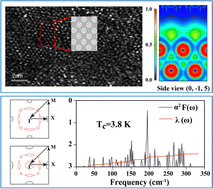
Nanoscale Horiz., 2023,8, 767-775
https://doi.org/10.1039/D2NH00508E
Eco-friendly inorganic molecular novel antiperovskites for light-emitting application
The novel antiperovskites exhibit a low dimensional electronic structure, making them a potential luminous material. Herein, our study explored the new and ecofriendly antiperovskites to identify six promising luminous candidates.
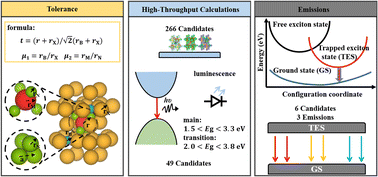
Mater. Horiz., 2023,10, 1678-1688
https://doi.org/10.1039/D2MH01216B
Flexible plasmonic nanocavities: a universal platform for the identification of molecular orientations
Plasmonic nanocavities enable the manipulation of field polarization, thereby to selectively enhance the Raman modes of specific target molecules.

Nanoscale, 2023,15, 6588-6595
https://doi.org/10.1039/D3NR01059G
A universal synthesis of ultrathin Pd-based nanorings for efficient ethanol electrooxidation
Metallic nanorings (NRs) with an open hollow structure are of particular interest in energy-related catalysis due to their unique features, which include the high utilization of active sites and facile accessibility for reactants.

Mater. Horiz., 2023,10, 1416-1424
https://doi.org/10.1039/D2MH01363K
Oligoaniline-assisted self-assembly of polyaniline crystals
The presence of a small amount of oligomer can induce ordering and crystallization of the parent conducting polymer, resulting in highly conductive, compositionally homogeneous crystals with defined molecular weights.

Mater. Horiz., 2023,10, 1282-1291
https://doi.org/10.1039/D2MH01344D
Developing extended visible light responsive polymeric carbon nitrides for photocatalytic and photoelectrocatalytic applications
Polymeric carbon nitride (CN) has emerged as an attractive material for photocatalysis and photoelectronic devices.
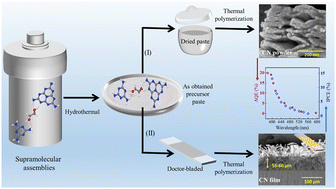
Mater. Horiz., 2023,10, 1363-1372
https://doi.org/10.1039/D3MH00016H
An interlayer spacing design approach for efficient sodium ion storage in N-doped MoS2
MoS2 in a graphene-like structure that possesses a large interlayer spacing is a promising anode material for sodium ions batteries (SIBs).
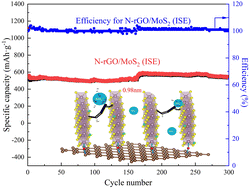
Nanoscale Horiz., 2023,8, 473-482
https://doi.org/10.1039/D2NH00488G
Discovering layered lead-free perovskite solar absorbers via cation transmutation
Dion–Jacobson double perovskites BDA2MIMIIIX8 are explored for stable and high-efficiency lead-free solar cell absorbers.

Nanoscale Horiz., 2023,8, 483-488
https://doi.org/10.1039/D2NH00499B
Highly anisotropic and ultra-diffusive vacancies in α-antimonene
α-Antimonene has recently been successfully fabricated in experiment; hence, it is timely to examine how various types of point defects in α-antimonene can affect its novel electronic properties.

Nanoscale, 2023,15, 4821-4829
https://doi.org/10.1039/D3NR00194F
Lattice disorder influences the photocarrier dynamics in lead halide perovskites
Photoinduced carriers recombine almost twice slower and diffuse 20% faster in the disordered, β-phased samples than in the ordered, γ-phased ones.
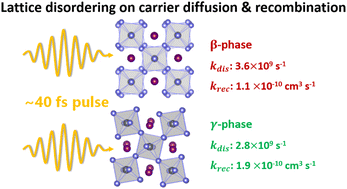
Mater. Horiz., 2023,10, 875-880
https://doi.org/10.1039/D2MH01212J
Giant electrocaloric effect in a molecular ceramic
The electrocaloric effect (ECE) is an efficient and environmentally friendly method for solid-state refrigeration driven by an electric field.

Mater. Horiz., 2023,10, 869-874
https://doi.org/10.1039/D2MH01296K
A self-healing polymerized-ionic-liquid-based polymer electrolyte enables a long lifespan and dendrite-free solid-state Li metal batteries at room temperature
We introduce a self-healing polymerized-ionic-liquid-based polymer electrolyte for solid-state Li metal batteries, which can spontaneously reconstruct dendrite-induced defects at the Li/electrolyte interface, and, in turn, tailor Li deposition.
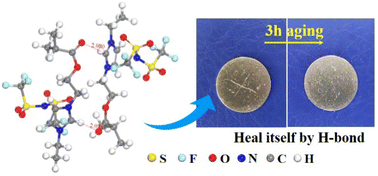
Mater. Horiz., 2023,10, 859-868
https://doi.org/10.1039/D2MH01289H
A simple descriptor for the nitrogen reduction reaction over single atom catalysts
The performance of supported catalysts is largely decided by metal–support interactions, which is of great significance for the rational design of catalysts.

Mater. Horiz., 2023,10, 852-858
https://doi.org/10.1039/D2MH01197B
Large-area silicon photonic crystal supporting bound states in the continuum and optical sensing formed by nanoimprint lithography
The quasi-BIC modes are formed in silicon photonic crystal slabs by controlling both the lateral and vertical etched geometries. A high Q factor of 136, sensitivity of 1703 nm per RIU and figure-of-merit of 65.5 are observed in the optical sensor experiments.

Nanoscale Adv., 2023,5, 1291-1298
https://doi.org/10.1039/D3NA00001J
High temperature phases of borophene: borophene glass and liquid
Large hole surrounded by a stable double-boron chain in liquid borophene.

Nanoscale Horiz., 2023,8, 353-360
https://doi.org/10.1039/D2NH00518B
Surface oxidation protection strategy of CoS2 by V2O5 for electrocatalytic hydrogen evolution reaction
V2O5 nanoclusters can inhibit CoS2 from serious surface oxidation in air, and the lower surface oxidation degree, the better HER performance.

Nanoscale Horiz., 2023,8, 338-345
https://doi.org/10.1039/D2NH00431C
Lithium storage performance and mechanism of nano-sized Ti2InC MAX phase
Nano-sized Ti2InC prepared by ball milling combines the benefits of insertion-type and alloy-type electrodes and thus has a favorable capacity and long cycling life, suggesting that downsized MAX phases would be a promising anode.
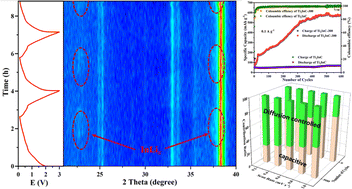
Nanoscale Horiz., 2023,8, 331-337
https://doi.org/10.1039/D2NH00489E
Thermodynamic mechanism of controllable growth of two-dimensional uniformly ordered boron-doped graphene
The thermodynamic mechanisms as well as the optimal experimental parameters of controllable growth of 2D uniformly ordered boron-doped graphene have been proposed by establishing the substrate-mediated phase diagrams.

Nanoscale Horiz., 2023,8, 346-352
https://doi.org/10.1039/D2NH00507G
Volcano relationships and a new activity descriptor of 2D transition metal–Fe layered double hydroxides for efficient oxygen evolution reaction
In two-dimensional (2D) Fe-doped MFe-LDHs, volcano-shaped relationships between the catalytic activity descriptors and the Fe contents are identified, and a new activity descriptor, the intermediate adsorption capacitance (CPEad), is proposed.
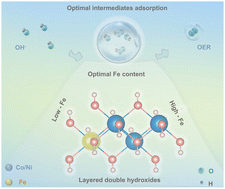
Mater. Horiz., 2023,10, 632-645
https://doi.org/10.1039/D2MH01217K
Theoretical exploration of the nitrogen fixation mechanism of two-dimensional dual-metal TM1TM2@C9N4 electrocatalysts
Four TM1TM2@C9N4 candidates (TM1TM2 = NiRu, FeNi, TiNi, and NiZr) with end-on N2 adsorption configuration, and two candidates (TM1TM2 = TiNi and TiFe) with side-on adsorption configuration, were screened out as high efficiency NRR catalysts.

Nanoscale Horiz., 2023,8, 211-223
https://doi.org/10.1039/D2NH00451H
Giant thermal switching in ferromagnetic VSe2 with programmable switching temperature
Active and reversible modulation in thermal conductivity can realize efficient heat energy management in many applications such as thermoelectrics.
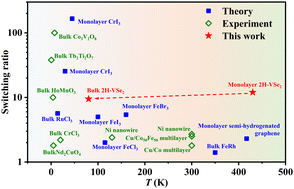
Nanoscale Horiz., 2023,8, 202-210
https://doi.org/10.1039/D2NH00429A
High-specificity molecular sensing on an individual whispering-gallery-mode cavity: coupling-enhanced Raman scattering by photoinduced charge transfer and cavity effects
This work proposes an ultrasensitive and high-specificity whispering-gallery-mode (WGM) sensing method, which combines the light-matter interaction enhancement on a WGM cavity and the “fingerprint spectrum” of surface-enhanced Raman scattering.

Nanoscale Horiz., 2023,8, 195-201
https://doi.org/10.1039/D2NH00450J
New horizons of MBenes: highly active catalysts for the CO oxidation reaction
O-functionalized orthogonal and hexagonal MBenes exhibit extremely high carbon monoxide oxidation reaction (COOR) catalytic activity and high thermal stability under 1000 K.
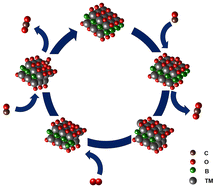
Nanoscale, 2023,15, 483-489
https://doi.org/10.1039/D2NR05705K
Flexible-in-rigid polycrystalline titanium nanofibers: a toughening strategy from a macro-scale to a molecular-scale
Electrospun TiO2 nanofibers could be reinforced from a macro-scale to a molecular-scale, by promoting length–diameter ratio, suppressing crystal sintering, repairing surface grooves, constructing lubrication zones, and toughening chemical bonds.

Mater. Horiz., 2023,10, 65-74
https://doi.org/10.1039/D2MH01255C
Cu and Si co-doping on TiO2 nanosheets to modulate reactive oxygen species for efficient photocatalytic methane conversion
The Cu and Si co-doping could rationally regulate the electronic structure of TiO2 nanosheets and maneuver the reactive oxygen species for methane activation, which achieves significant photocatalytic methane conversion into ethane.
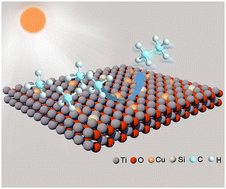
Nanoscale Horiz., 2023,8, 63-68
https://doi.org/10.1039/D2NH00457G
Highly efficient electrocatalytic biomass valorization over a perovskite-derived nickel phosphide catalyst
A perovskite-derived nickel phosphide catalyst exhibits excellent electrocatalytic oxidation performance for biomass valorization to replace the competitive oxygen evolution reaction.
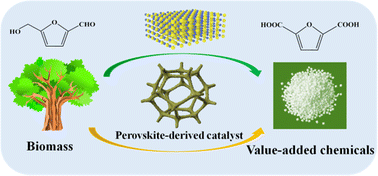
Nanoscale Horiz., 2023,8, 69-74
https://doi.org/10.1039/D2NH00391K
In situ crafting of a 3D N-doped carbon/defect-rich V2O5−x·nH2O nanosheet composite for high performance fibrous flexible Zn-ion batteries
In situ anodic oxidation strategy is demonstrated to fabricate flexible long-life and high-capacity aqueous zinc-ion batteries adopting a 3D N-doped/defect-rich V2O5−x·nH2O nanosheets as fibrous cathodes and Zn nanosheets arrays as the anode.

Nanoscale Horiz., 2022,7, 1501-1512
https://doi.org/10.1039/D2NH00349J
Achieving circularly polarized luminescence and large piezoelectric response in hybrid rare-earth double perovskite by a chirality induction strategy
A pair of 3D hybrid rare-earth double perovskites with large piezoelectric responses and CPL was constructed by introducing chirality. This study provides a strategy to prepare high-performance molecule-based piezoelectric and CPL materials.

Mater. Horiz., 2022,9, 2450-2459
https://doi.org/10.1039/D2MH00698G
N and S co-doped nanosheet-like porous carbon derived from sorghum biomass: mechanical nanoarchitecturing for upgraded potassium ion batteries
Nanosheet-like sorghum biomass obtained by mild alkaline treatment and high-energy ball milling is heteroatom-doped with N and S during pyrolysis. The resulting N, S co-doped carbon shows a significantly improved K-ion storage as an anode material in potassium ion batteries.
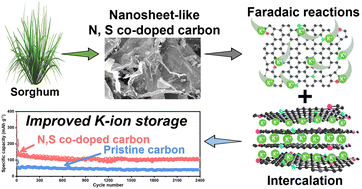
J. Mater. Chem. A, 2023,11, 16626-16635
https://doi.org/10.1039/D3TA03215A
Carbon nanowires made by the insertion-and-fusion method toward carbon–hydrogen nanoelectronics
Carbon nanowires can be made via the insertion-and-fusion of short carbon chains inside carbon nanotubes, and carry H adatoms that can tune the electronic and magnetic properties of carbon chains upon the varied H positions in C–H nanoelectronics.
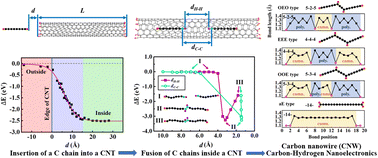
Nanoscale, 2023,15, 6143-6155
https://doi.org/10.1039/D3NR00386H
Nitrogen- and sulfur-doped graphene quantum dots for chemiluminescence
Chemiluminescence (CL) of NS-GQDs in the presence of CPPO and H2O2 was discovered to be a concerted process of intrinsic structure, AIE and surface state emissions by means of spooling CL spectroscopy and absolute CL efficiency measurements.

Nanoscale, 2023,15, 3864-3871
https://doi.org/10.1039/D2NR07213K
Atmospheric humidity-triggered reversible spin-state switching
By confinement into a hygroscopic sponge, reversible spin-state switching and color variation has been triggered by naturally occurring humidity capture/release cycles, providing a prototype for molecular switches mediated by natural energy.
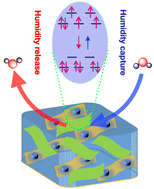
J. Mater. Chem. A, 2023,11, 1232-1238
https://doi.org/10.1039/D2TA08632H
A study on the role of plasmonic Ti3C2Tx MXene in enhancing photoredox catalysis
This work unravels that the plasmon-induced electric field enhancement of Ti3C2Tx cooperates with the electron-reservoir role to extract photoinduced electrons, affording multichannel electron transfer towards improved photocatalytic efficiency.
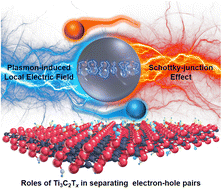
Nanoscale, 2022,14, 18010-18021
https://doi.org/10.1039/D2NR05983E
Bismuth–nickel bimetal nanosheets with a porous structure for efficient hydrogen production in neutral and alkaline media
A Bi–Ni bimetal nanosheet with mesoporous structure is prepared via a self-template electrochemical in situ method. The alloying effect between Bi and Ni regulated the electronic structure, thus improving the intrinsic activity of Bi–Ni catalyst.

Nanoscale, 2022,14, 17210-17221
https://doi.org/10.1039/D2NR04407B
About this collection
Guest Edited by Professor Jinlan Wang (Southeast University, China), Professor Yuanjian Zhang (Southeast University, China), Professor Seeram Ramakrishna (National University of Singapore, Singapore) and Professor Guihua Yu (The University of Texas at Austin, USA).
In conjunction with the Emerging Investigator Forum celebrating the 120th anniversary of Southeast University, we are delighted to present a collection of articles published in Materials Horizons and Nanoscale Horizons focusing on new horizons in materials for energy conversion, optics and electronics.
Energy materials, particularly those with nanoscale features, present unique physicochemical properties that make them perfect to be explored in diverse manners, paving the way towards renewable energy systems via continuous breakthroughs. Meanwhile, theoretical calculations, such as machine learning methods, have been widely applied to solve complex problems. This collection focuses on energy conversion, optics, and electronics applications of (nano)materials and provides an overview of the most frequently used experimental approaches and theoretical methods for energy conversion and storage, intending to connect different communities and identify common challenges in the field.